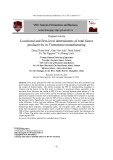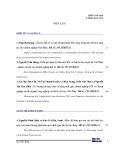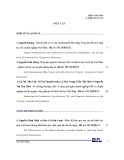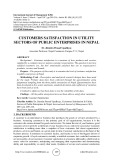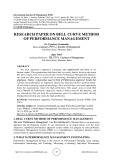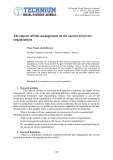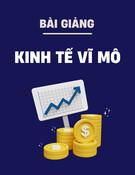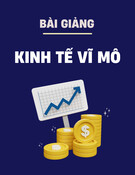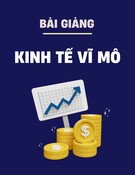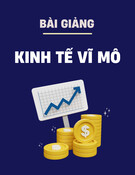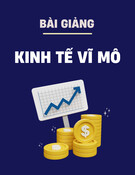
http://www.iaeme.com/IJMET/index.asp 244 editor@iaeme.com
International Journal of Mechanical Engineering and Technology (IJMET)
Volume 10, Issue 03, March 2019, pp. 244-251. Article ID: IJMET_10_03_025
Available online at http://www.iaeme.com/ijmet/issues.asp?JType=IJMET&VType=10&IType=3
ISSN Print: 0976-6340 and ISSN Online: 0976-6359
© IAEME Publication Scopus Indexed
ANALYSIS OF THE EFFECT OF BUSINESS,
TECHNOLOGY AND HUMAN RESOURCES
CAPITAL ON BUSINESS PERFORMANCE IN
THE NOKEN BAGS CRAFTSMEN IN MERAUKE
Marlyn Eleida Alfons and Semuel Batlajery
Universitas Musamus, Merauke, Indonesia
ABSTRACT
This research was conducted with the aim to determine the effect of business
capital, technology and human resources on the business performance of bag noken
craftsmen in Merauke. The research approach taken in this study is to use a
quantitative research approach because the data is related to numbers. The
population in this study were 53 people, namely business owners. Data collection
methods used by the authors in this study were observation, questionnaires and
interviews. In this study researchers used 3 (three) variables including; 2 independent
variables and 1 dependent variable. Data Analysis Techniques used are validity test,
reliability test, multiple linear regression analysis. The results showed that the
Business Capital, Technology and Human Resources variables obtained F_count
40.666> 3.10 F table. It can be concluded that H4 is accepted and H0 is rejected,
meaning that there is a significant effect of the independent variable on the dependent
variable with a significant level of 0,000 <probability sig 0.05. The F test results are
known F count> F table with a significant level <0.05, so it can be concluded that the
variables of venture capital, technology and human resources have a positive and
significant effect on business performance in the Noken bags craftsmen in Merauke.
Keywords: Business Capital, Technology, Human Resources, Business Performance
Cite this Article Marlyn Eleida Alfons and Semuel Batlajery, Analysis of the Effect
of Business, Technology and Human Resources Capital on Business Performance in
the Noken Bags Craftsmen in Merauke, International Journal of Mechanical
Engineering and Technology, 10(3), 2019, pp. 244-251.
http://www.iaeme.com/IJMET/issues.asp?JType=IJMET&VType=10&IType=3
1. INTRODUCTION
Noken Bag Craftsmen are classified as Micro, Small and Medium Enterprises (MSMEs) in
Merauke. Micro, Small and Medium Enterprises have a very strategic role in developing the
national economy, this can be seen directly that there is a high absorption of labor from this
sector. the business is the backbone of a populist economic system that is not only shown to

Analysis of the Effect of Public Relation And Sales Promotion on Decision Making Processes For
Buying Water Refills in Merauke
http://www.iaeme.com/IJMET/index.asp 245 editor@iaeme.com
reduce the problem of inequality between income groups and between business actors, or
poverty alleviation and employment.
The company or business sector in order to continue to carry out its business activities is
with the existence of business capital. Capital is one of the most important factors of
production activities. For companies that are newly established or start running their business,
capital is used to be able to run business activities, while for companies or business fields and
businesses that have long established, capital is usually used to be able to expand business and
expand market share of business and business venture capital according to Large Indonesian
Dictionary in Listyawan Ardi Nugraha (2011: 9) "Business capital is money used as a
principal (parent) to trade, release money, etc .; property (money, goods, etc.) that can be used
to produce something that adds wealth ". Capital in this sense can be interpreted as a sum of
money used in carrying out business activities.
Technology is the whole means to provide goods needed for the survival and comfort of
human life. Technology according to Miarso (2007) is a form of process that increases added
value. The running process can use or produce certain products, where products are not
separate from other existing products. It also states that technology is an integral part of what
is contained in a particular system.
According to Hasibuan (2003, h 244) Human Resources is an integrated ability of the
power of thought and physical power possessed by individuals. Actors and their
characteristics are carried out by their offspring and environment, while their performance is
motivated by the desire to fulfill their satisfaction. Human resources consist of the thinking
power and physical power of every human being. Strictly the ability of every human being is
determined by the power of thought and physical power. Human resources are the main
element in every activity carried out. Reliable or sophisticated equipment without the active
role of human resources, means nothing. Thinking power is intelligence that is carried out
from birth (basic capital) while skills are obtained from business (learning and training).
Measuring intelligence is Intelligence Quotient (IQ) and Emotion Quality (EQ).
Every company must always review the performance of the company in a certain period.
This activity is often also called company performance. Company performance has an
understanding as a result of a management activity in a company. The results of management
activities are then used as a parameter or benchmark to assess the success of the management
of a company in terms of achieving goals that have been set in a certain period. In addition to
this general understanding, there are many opinions expressed by several experts regarding
the understanding of the company's performance which can be used as a reference in defining
the performance of this company. According to Moerdiyanti (2010), reveals that company
performance is the result of a series of business processes which by sacrificing various kinds
of resources, namely human resources and corporate finance. If the company's performance
increases, it can be seen from the incessant activities of the company in order to generate
maximum profits. The profits or profits generated will certainly differ depending on the size
of the moving company. Based on the process of increasing income earnings or profits,
Nakamura (2011: 102) states that companies that have a large size have greater potential to
invest their resources. In managing this investment, companies should as much as possible be
able to create value for shareholders.
2. METHODOLOGY
This research was carried out on the Tas Noken craftsmen, which numbered 53
craftsmen according to 2017 BPS data found in several places in Merauke City.
The research approach taken in this study is to use a quantitative research

Semuel Batlajery and Marlyn Alfons
http://www.iaeme.com/IJMET/index.asp 246 editor@iaeme.com
approach because the data is related to numbers. The population in this study
were 53 people, namely business owners. then the determination of the number
of samples in this study uses the total sampling method.
The data used in this study are; Primary data is data obtained directly from
original sources (Mangkoedihardjo and April, 2012; Mangkoedihardjo, 2007).
This study uses primary data from the results of filling out questionnaires given
to respondents regarding the identity of respondents (age, sex, education, length
of work) and respondent's responses. Secondary data is data obtained indirectly
through intermediary media. This study uses secondary data obtained from
journals, magazines, books, and previous studies that make information or data
relating to research in the form of evidence, records or historical reports that
have been compiled in both published and unpublished archives.
Data collection methods used by the authors in this study were observation,
questionnaires and interviews. In this study researchers used 3 (three) variables
including; 2 independent variables (Independent variables) and 1 dependent
variable (dependent variable). Data Analysis Techniques used are Validity Test,
Reliability Test, Multiple Linear Regression Analysis, According to Hasan (2008)
the multiple linear regression equation is as follows: Y = a + b1 x1 + b2 x2 + b3
x3 + e where; Y: Business Performance, a: Constants, b: Correlation coefficient,
X1: Business Capital, X2: Technology, X3: Human Resources, e: error / error,
using the SPSS for Windows 23 Program to facilitate analysis.
3. RESULTS
3.1. Validity test
Validity test is done by comparing r_count with r_tabel for degree of freedom (df) = n-2, in
this case n is the number of samples. Large (df) = 53-2, the number 51 is obtained, with alpha
= 0.05 obtained r_tabel 0.2084 using the formula person corelation. Based on the results of
data processing it is known that the whole item variable is valid because r_count> r_tabel is a
significant level of 95% (α = 0.05) and n = 20 is obtained> r_tabel = 0.2084 so that it can be
said that the whole item of variable questionnaire is valid.
3.2. Test reliability
Reliability testing is done by using Croanbach's Coeficient Alpha which shows how far the
items in the study are correlated with each other. The value of an instrument is said to be
reliable if it has a value of croanbach's alpha> 0.6. Reliability test is used to determine the
consistency of the measuring instrument, whether the measuring instrument used is reliable
and remains consistent if the measurement is repeated. According to Dwi (2009) that
reliability is less than 0.60 is not good, while 0.70 is acceptable and 0.80 is good.
The reliability test results obtained alpha coefficient for the Business Capital variable
0.714, the Technology variable 0.692, the Human Resource Variable 0.723 and the Business
Performance variable 0.829, these values> 0.60 Cronbach Alpha Standard. This means that
the statement item used will be able to obtain consistent data, meaning that if the statement is
submitted again, a relatively similar answer will be obtained with the first answer.

Analysis of the Effect of Public Relation And Sales Promotion on Decision Making Processes For
Buying Water Refills in Merauke
http://www.iaeme.com/IJMET/index.asp 247 editor@iaeme.com
Table 1. Reliability test results
Coefficientsa
Model
Unstandardized Coefficients
Standardized
Coefficients
t
Sig.
B
Std. Error
Beta
1
(Constant)
.280
3.607
.078
.938
Venture Capital
.510
.112
.389
4.564
.000
Technology
.598
.119
.450
5.667
.000
Human Resources
.564
.115
.512
5.786
.000
a. Dependent Variable: Business Performance
Based on the table above, the multiple regression equation is obtained as follows: Y =
0.280 + 0.510 + 0.598 + 0.564 + e. The above equation can be explained that:
a. The constant coefficient of 0.280, shows that if the business capital variable (X1)
Technology (X2) and Human Resources (X3), the value is 0 then the business performance
(Y) value is 0.280.
b. The business capital variable regression coefficient (X1) is 0.510, meaning that if
business capital increases by 1% then the business performance variable (Y) will increase by
0.510.
c. Technology variable regression coefficient (X2) 0.598, meaning that if innovation
increases by 1% then the business performance variable (Y) will increase by 0.598.
d. Regression coefficient of human resource variable (X3) 0.564, meaning that if
innovation increases by 1% then the business performance variable (Y) will increase by
0.564.
3.3. Hypothesis testing
3.3.1. Test t
The t test basically shows how far the influence of two independent variables namely
Business Capital (X1) Technology (X2) and Human Resources (X3) individually in
explaining the variation of the dependent variable namely Business Performance (Y). This
decision is made based on a comparison of t count> t table with a predetermined level of
significance, which is equal to 5% (α = 0.05). Business Capital Variables have a significant
effect on Business Performance, this can be seen from the value of t_count 4.564> t_table
1.66256. So the hypothesis taken is H1 accepted and H0 rejected, with a significant level of
0,000 <probability sig 0.05.
Technology variables have a significant effect on Business Performance, this can be seen
from the value of t count 5.667> t table 1.66256. So the hypothesis taken is H2 is accepted
and H0 is rejected, with a significant level of 0,000 <probability sig 0.05.
Variables of human resources significantly influence Business Performance, this can be
seen from the value of t count 5.786> t table 1.66256. So the hypothesis taken is H2 is
accepted and H0 is rejected, with a significant level of 0,000 <probability sig 0.05.
3.3.2. Test F
The F test basically shows whether all the independent variables included in the model have a
simultaneous influence on the dependent variable. Decision making is done based on the
comparison of the value of f_count> f_table with a predetermined level of significance (5% or
0.05).

Semuel Batlajery and Marlyn Alfons
http://www.iaeme.com/IJMET/index.asp 248 editor@iaeme.com
Table 2. ANOVAa
Model
Sum of Squares
Df
Mean Square
F
Sig.
1
Regression
745.046
2
372.523
40.661
.000b
Residual
787.898
86
9.162
Total
1532.944
88
a. Dependent Variable: Business Performance
b. Predictors: (Constant), Venture Capital, Technology, Human Resources
From the results of the F test, the F-count value is 40,661 and the F_table value is 3,10.
The value of F table can be obtained from DfI = k-1 = 2, and Df2 = nk = 53-4 = 49, where df
= degrees are free, n = number of samples and k = number of variables (free and bound) so
that the value is F_tabel While the significance is 0,000. Because the significance value is
below 0.05 and the value of F_count is greater than the value of F table (40.666> 3.10), it is
stated that Ha is accepted meaning that business capital and innovation have a positive and
significant effect together on business performance.
3.4. Coefficient of determination (R2)
To see the ability of the independent variable to explain the dependent variable. The results of
the coefficient of determination can be seen in table 3. the following:
Table 3. Model Summaryb
Model
R
R Square
Adjusted R Square
Std. Error of the Estimate
1
,697a
,486
,674
3,027
a. Dependent Variable: Business Performance
b. Predictors: (Constant), Venture Capital, Technology, Human Resources
Based on the results of calculations using SPSS version 23 as can be seen in the table
above, the researcher took the data in the Adjusted R column because this study has more than
one independent variable, it is known that R ^ 2 or Adjusted R value is 0.674 means that all
independent variables are the same effect on Purchasing Decisions of 67.4% while the
remaining 32.60% is influenced by other unknown variables in this study.
4. DISCUSSION
By involving 53 respondents in this study who provided information on the influence of
Business Capital, Technology and Human Resources on the business performance of Tas
Noken craftsmen in Merauke, it can be described as follows:
4.1. Effect of business capital on business performance
Based on the results of the study indicate that the business capital variable obtained t-count
value of 4.564 with a significance value of 0.000 smaller than 0.05 (0,000 <0.05), and the
regression coefficient has a positive value of 0.510, this study successfully proved the first
hypothesis stating that "Business capital variables have a positive and significant effect on
business performance. This research is in line with the theory put forward by Listyawan Ardi
Nugraha (2011: 9) "Business capital is money that is used as the principal (parent) to trade,
release money, etc.; property (money, goods, etc.) that can be used to produce something that
adds wealth ".


